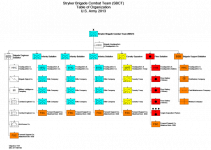- Reaction score
- 11,931
- Points
- 1,160
Here's my thought which I've already floated a month or so ago.
The Army has enough folks for about two divisions or so and enough equipment for one if everyone and everything was mobilized and deployed at once. So from a tactical viewpoint do we need more than one deployable divisional headquarters? No. Do we need administrative headquarters below Army level? - probably, 40,000+ folks need to be broken up in clumps so how many clumps can Army HQ manage. 40,000 folks add up to about 8 brigade size clumps (based on a brigade being roughly 3-5,000 folks depending on type). Can one headquarters control 8 clumps. Sure they can - it's a bit over optimum but quite doable and in not having an intermediate headquarters you have tighter control (not to mention saving the resources of the intermediate headquarters).
Based on manpower authorizations (ignore standards of training for the time being) we have people for roughly 4 equipped RegF brigades and 4 ResF underequipped ones.
So why bother keeping a ResF brigade headquarters at all? Well here's where I go in a different direction based, not on mobilization needs, but based on day to day Army deployment roles during peacetime.
Afghanistan built us a model where we deploy individual battlegroups supervised by brigade headquarters for periods of six months and nine months. SSE says we need to be able to deploy simultaneously two sustained battlegroups and one short duration battlegroup as well as two sustained and one short term force of less than battlegroup size. That's the potential for up to six elements simultaneously which means we need a generous command and control capability.
Canada currently has three (and one CS) bde HQs and 12 battle group HQ which are adequately staffed and trained for deployments. The other ten brigades and seventy some odd battalion HQs are entirely inadequate for that. That's not enough to sustain the SSE model adequately without much ad hocery and wearing out people. On the other hand, with a total of eight properly staffed brigades and 24 or so properly staffed battlegroup HQs we double that peacetime deployment capability. The key here is "properly staffed". That means full-time Reg F leadership and staffs.
Just one aside here. I do not see all the brigades and battle groups here as manoeuvre ones. If we properly analyze our defence needs and structure, I see retaining three Reg F manoeuvre brigades with 12 battlegroups, two Res F brigades with 8 battlegroups. one RegF CS brigade with one battlegroup, one ResF CS brigade with one battlegroup and one ResF CSS brigade with one battlegroup (the colocation of battlegroups with the CS and CSS brigades is mostly due to geographic factors and existing locations of sufficient combat arms reservists in those locals)
Again, a key here is "battlegroup HQs" as these are the entities we wish to be the C&C elements on deployment. I do not think that a given RegF battlegroup needs a full complement of RegF manoeuvre companies. Again, Afghanistan has given us a model of building block battlegroups formed by company size elements from a disparate group of battalions. IMHO in order to be a properly trained battlegroup headquarters it needs: a mostly fully staffed full-time headquarters; at least one full-time company to train and generate career development through and to provide a rapid reaction force; at least one ResF company to be augmented from and to provide additional company HQ staff to allow exercising at battle group level; access to appropriate battle group CSS elements to train with and draw on for deployment; access to appropriate CS elements to train with and draw on for deployment.
The point here is that with enough full-time brigade, battlegroup and company level staff you can train for all natures of operations even when many of the troops themselves are part-time reservists who only train and deploy occasionally. It's kind of a TEWT thing but with enough troops to add an additional layer of complexity. In effect the full-time Bde and BG HQs and Reg F Coy leadership form the backbone while RegF and ResF companies form the flesh in varying ratios.
This effectively is where the 70/30 concept comes from - every brigade and battalion has a deployable headquarters and at least one deployable sub-unit. Headquarters and deployable RegF subunits are fully equipped and share their equipment with their ResF counterparts. There are no longer any administrative bde or battalion HQs. Generally speaking, RegF 70/30 units have two RegF deployable subunits and a larger share of CS and CSS while ResF 30/70 units have one deployable RegF subunit and a lesser share of CS and CSS elements. Sub units become plug and play elements added to a given mission. In a major emergency, the entire force can be mobilized in whole or in part with the only real limitation being equipment available. The overall objective should be to start acquiring new equipment on a scale to equip ever larger elements of the total force and thereby enhance deployability. And I should mention that "deployable" is not synonymous with "expeditionary". Any unit should be capable of deploying internationally or domestically using its core RegF personnel as well as either volunteer or mobilized ResF members from its own or other units.
Training facilities and base infrastructure is consolidated under Army HQ. I would have CADTC control all recruiting and training through it's existing facilities as well as through depot battalions located at each of the current training centres and who also command depot companies, platoons and detachments down to local armoury level - one overarching individual and collective training system. Similarly all infrastructure remains under Army HQ. In a worse case scenario, an entire brigade could pack up and deploy and yet the training and support infrastructure would remain in place and be capable of recruiting and generating a new brigade insitu.

And the battle group has become the new metric it seems.
Dispersed Operations.
TASS,
10 AUG 2021, 07:50
Russian Army operates around 170 battalion tactical groups — defense chief
These are the forces that are ready for deployment in an hour after an alert signal, Sergey Shoigu pointed out
SOLNECHNOGORSK /Moscow Region/, August 10. /TASS/.
Around 170 battalion tactical groups are operational in the Russian Army today, Defense Minister Sergey Shoigu said on Tuesday.
"Today we actually have constant alert troops. Today we have no forces that we need to gather and find. All the troops are on constant alert. We have formations called battalion tactical groups. These are the forces that are ready for deployment in an hour after an alert signal. We have 168 such groups today and this is a very high figure," the defense chief said at the Territory of Senses educational youth forum.
A battalion tactical group is a temporary operationally flexible formation set up on the basis of a battalion and attached artillery, air defense, engineering and logistics support units for combat operations as part of motor rifle and tank brigades. Aviation groups, special operations forces and other units can also be attached to a battalion tactical group to accomplish assigned missions.
Ukraine: How big is Russia's military build-up?
By David Brown
BBC News
19 January, 2022
Russia has moved about 100,000 troops - equipped with everything from tanks and artillery to ammunition and air power - to Ukraine's border but denies it is planning an invasion.
About 35,000 Russian personnel are permanently stationed near Ukrainian territory.
Some newly arrived units have travelled almost 4,000 miles, from the Russian Far East.
Most estimates put the number of Russian troops deployed around Ukraine - to the country's north, south and east - at about 100,000.
But one Ukrainian assessment, reported by CNN, says there are 106,000 ground troops and 21,000 navy and air-force personnel.
On Tuesday, UK Prime Minister Boris Johnson said: "The intelligence is very clear that there are 60 Russian battle groups on the borders of Ukraine," about a third of the total available numbers.
In addition to the regular Russian troops, there are thought to be about 15,000 Russian separatists in Ukraine's Luhansk and Donetsk regions.
We used to talk about Army Groups. Now we talk about Battlegroups. That in and of itself is a significant de-escalation in the temper of human affairs.








